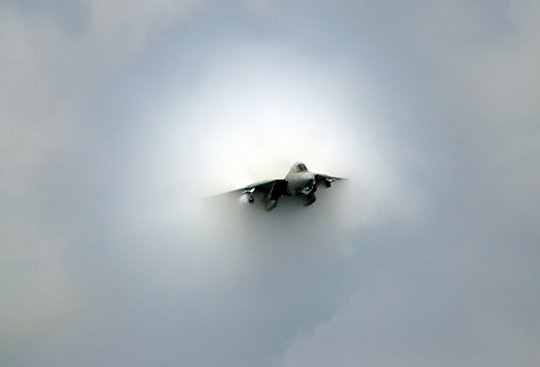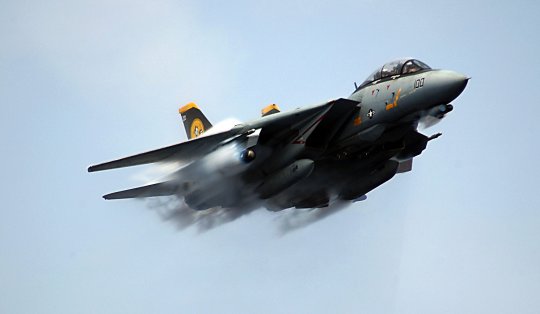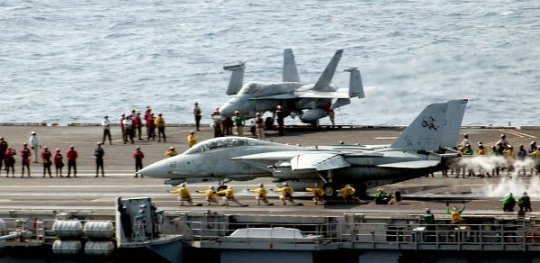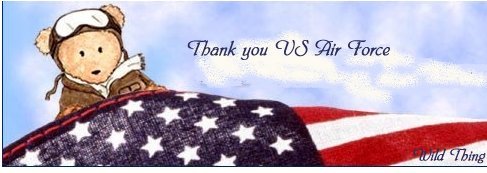« Truth About Islam From An Ex-Muslim | Main | Guard the Borders Blogburst »
August 07, 2006
Tomcat Chapter Draws to a Close
Forever-Fearsome F-14 Tomcat Fighter Jet's Last Official Launch, Flyby, Landing



Aboard USS Theodore Roosevelt (CVN 71), an F-14D Tomcat assigned to the "Tomcatters" of Fighter Squadron Three One (VF-31), aircraft number 112, accelerates down the ship’s number three catapult during the final launch of an F-14 Tomcat fighter aircraft.
Tomcat Chapter Draws To a Close
ABOARD USS THEODORE ROOSEVELT (NNS) --
A long, storied chapter in naval aviation history came to a close July 28 with the final aircraft carrier flight operations for F-14 Tomcats, fighter jets that have spent more than 32 years in the fleet but are now retiring and making room for F/A-18E/F Super Hornets.The final aircraft carrier operational launch for Tomcats happened aboard the Norfolk-based Nimitz-class aircraft carrier USS Theodore Roosevelt (CVN 71) when aircraft No. 112 from the "Tomcatters" of Fighter Squadron (VF) 31, piloted by Lt. Blake Coleman and Radar Intercept Officer Lt. Cmdr. Dave Lauderbaugh, made its way down catapult No. 3 at 4:42 p.m.
"Bittersweet is a perfect term for this," said Tomcatters' Commanding Officer, Cmdr. Jim Howe. "As a career F-14 pilot, I would be much happier flying the Tomcat until the end of my days in the Navy. But instead we have to enjoy this as long as we can."
The Navy's transition from the F-14D Tomcat fighter jet to the F/A-18E/F Super Hornet, a strike-fighter aircraft, is all but complete, as Carrier Air Wing (CVW) 8's Tomcatters now make up the final F-14 squadron.
As part of the final transition, F-14 pilots and maintainers will take on any necessary additional training and learn the ins and outs of Super Hornets, which Howe said is a much easier aircraft to work with.
"One of the reasons the Tomcat is going away is because it's so hard to fix," Howe said. "I'm happy for my young maintenance guys, because they've worked their tails off and they can fix just about anything. So, this transition to the Super Hornet, because that particular aircraft is so much easier to maintain, will be an easy one for them."
Dating back to its initial combat missions during Vietnam and spanning to its most recent combat missions in the Persian Gulf, the F-14 Tomcat has played a vital role in naval aviation.
The Tomcat entered operational service with Navy fighter squadrons VF-1 Wolfpack and VF-2 Bounty Hunters aboard USS Enterprise (CVN 65) in September 1974. The F-14's purpose was to serve as a fighter interceptor, eventually replacing the F-4 Phantom II Fighter, which was completely phased-out in 1986.
Although its dogfighting superiority had already been made clear through simulated training missions, the F-14 was first tested in combat operations in August 1981. While on patrol outside Libya, two F-14As were fired upon by two Libyan Sukhoi SU-22s. The Tomcat pilots safely maneuvered from a defensive position to an offensive one before engaging and destroying both SUs.
Four years later in 1985, F-14s were called upon in response to the hijacking of an Italian cruise ship. The terrorists, who were from the Palestine Liberation Organization, attempted to make an escape after going ashore and boarding a Boeing-737 commercial airliner. Tomcats from VF-74 and VF-103 were launched from USS Saratoga (CV 60) to intercept the 737. The terrorists, realizing they were no match for the Tomcat's air-to-air attack capabilities, allowed the airliner to safely land in Sigonella, Sicily.
In 1989, the Tomcat was once again challenged by Libya when two MiG-23 Floggers engaged two F-14As from VF-32 that were flying combat air patrol missions from aboard USS John F. Kennedy (CV 67). The MiG-23s were determined hostile and the eight-minute engagement resulted in the downing of both Floggers.
During its first 17 years of operational service in the Navy, the Tomcat played a vital role as an interceptor with its air-to-air capabilities. However, during the 1991 Persian Gulf War, where there was more need for air-to-ground abilities, the need for the Tomcat's air-to-air capabilities diminished.
Despite its many upgrades over the years, from the F-14A, to the F-14B, and finally the F-14D with its powerful GE F110 engines and more sophisticated weaponry and surveillance equipment, it appeared the Tomcat's days were fading fast.
However, this state of uncertainty wouldn't last for long. Shortly following the Persian Gulf War, Navy leaders decided to devise removable bomb racks for Tomcats to allow them to carry MK-80 "dumb" bombs. The Tomcats were also given the Low-Altitude Navigation and Targeting Infrared for Night (LANTIRN) targeting system to allow for delivery of laser-guided bombs. With its new upgrades the Tomcat's were soon dubbed "Bombcats."
"This aircraft has done a lot for naval aviation history," said Senior Chief Aviation Structural Mechanic (AW) Fred Parker. "It's obviously been through, and played a vital role in, many wars and evolutions."
During the proceeding years, the F-14s took on a new, more effective role as a fighter-bomber.
In Operation Deliberate Force in Bosnia, the Tomcats delivered laser-guided bombs while other aircraft painted the targets with lasers. The Navy was credited with 30 percent of the kills against forces in Kosovo as a result of the bombing performance of the Tomcat.
The F-14 also demonstrated its ground attack capabilities in Afghanistan and Operation Iraqi Freedom. In 2002, VF-14 led the first long-range tactical air strike, flying more than 1,700 miles round trip to Mazar-e Sharif, destroying Taliban aircraft on the ground. During Operation Iraqi Freedom, the Tomcats lived up to their "Bombcat" nickname with their air-to-ground missions, continuing to save the lives of coalition ground forces.
"I will never forget flying a ‘show of force' over a city in Iraq where our troops were taking fire from insurgents," said Lt. Cmdr. Gregory Knepper, a pilot for VF-31. "After making a high speed/low altitude pass over the shoot-out, the insurgents fled and hopefully, we saved the lives of some of our Soldiers. The Tomcat has been a phenomenal part of naval aviation. It will be sad to see such a storied fighter decommissioned."
The Tomcat has been leading the way in naval aviation for some time now, but just like a senior Sailor retiring to make way for a new up and coming junior Sailor, it is time for the Tomcat to retire and make way for the Super Hornet.
"A lot of the guys in the squadron have been upbeat and we've been having a great time, but this is bittersweet," said Lt. Chris Rattigan, a pilot for VF-31 who piloted the final arrested landing today. "Now we'll transition to the F/A-18E, which is a single-seat version of the Super Hornet. It's okay though. I'm just glad to have gotten the chance to be a part of this aircraft. It's been a lot of fun. This is something I've always wanted to do growing up, and I was lucky enough to be able to do it."
TR is currently training as part of the USS Dwight D. Eisenhower (CVN 69) Carrier Strike Group Joint Task Force Exercise (JTFEX) in the Atlantic Ocean.
Additional F-14 Tomcat Photos, 28 July 2006, USS Theodore Roosevelt (CVN 71) in the Atlantic Ocean:
Page ONE
Page TWO
Page THREE
Page FOUR
Page FIVE
Page SIX
Page SEVEN
Page EIGHT
Page NINE
Page TEN

Wild Thing's comment.....
I think this is sad.
If you want to see one of these beautiful machines, go the Ronald Reagan library in Simi Valley, California. They have on of these aircraft outside and the actual Air Force 1 (Tail # 27000) inside the library. Quite an impressive visit for a VERY impressive man.
Posted by Wild Thing at August 7, 2006 09:55 AM
Comments
I remember the first time I saw one of these, I was at the far end of a large 30 mile long lake in a remote area fishing when two of them came up the lake at low level and high speed, then as they approached the shore and mountains they pulled up and went straight up and out of sight, in seconds. I didn't know whether they were Migs or ours as it all happened so fast that I only got a glimpse of them. It was like what the...what was that? I had the same sense of awe last year while watching the F/A-18E perform. Yes it's sad, I hate to see them go.
Posted by: Jack at August 7, 2006 12:53 PM
That was one of my favorite jets as a kid. I thought they were the coolest thing flying. What a shame.
Posted by: raz0r at August 7, 2006 02:04 PM
Jack what a great story.
Posted by: Wild Thing at August 7, 2006 07:10 PM
razOr I agree they are so impressive.
Posted by: Wild Thing at August 7, 2006 07:11 PM
Oh well,
I hate to see that big monster of a fighter go, like Jack I've had a bit of fun watching these birds fly, wish I'd got a chance to get a supersonic flyby, never happened as all my encounters we're in country. (guess some don't like the noise)
grab your copy of top gun, pour yourself a scotch, and toast the proud service of a great (big) fighter.
Posted by: Mark at August 8, 2006 10:22 AM
Mark I love this......
"grab your copy of top gun, pour yourself a scotch, and toast the proud service of a great (big) fighter."
Big smile on my face!
Posted by: Wild Thing at August 8, 2006 05:13 PM
